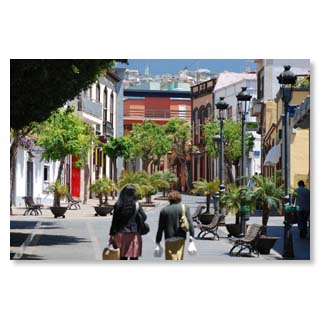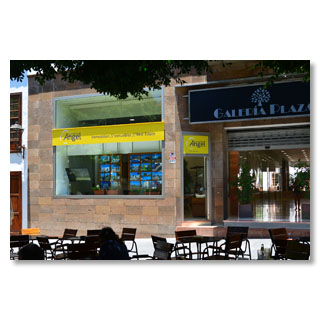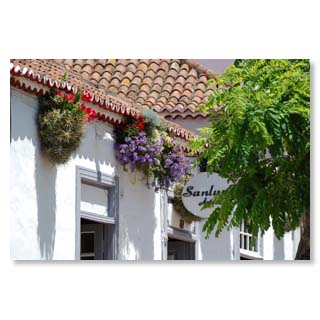Los Llanos de Aridane
Los Llanos is the secret capital of La Palma. In the previous century the port of entry in Santa Cruz de La Palma was a determining factor in the importance of the capital. The economic importance of banana cultivation and later tourism in Los Llanos has grown steadily since the beginning of the twentieth century, making the city at least equally significant today with the actual capital. The inhabitants are constantly working on the embellishment of their beloved city, so that it has developed into a real pearl of the Canary archipelago.

Cool shade provides this pergola from Bougainville to the guest next to the church at Plaza de España …

... where the really important things are regulated…

The imposing three-naves church 'Nuestra Señora Virgen de los Remedios' from the 16th century towers above the city…

... and impresses also in the inside by the enormous ceiling construction from Tea-wood.

Church roof at the Plaza de España

The plaza is followed by quiet alleys in the old town, like here the Calle Real…

... with their colourful shops…

... the wall-paintings…

... street cafés …

....the colourful shops......

... and historical buildings.

It ends with a well that cannot hide our proximity to Africa.

And what would La Palma be without its balconies?

Here you take your time to look at life.

Moorish fountain

People like to talk to each other a lot and always'tranquilo

Calle Carballo leads to the…

... archaeological museum, …

... which was accommodated in a modern round building.

The 'Museo Arqueològico Benahoarita' shows artefacts…

... from the time of the 'Guanches', the natives of La Palma.

A small shopping arcade leads to Fernández Taño street…

... with the Café Utopía …

... and our office at the Plaza de España, where we welcome you warmly.

Via the Plaza Chica you get back to the…

... big plaza, where even the mannequins sun themselves.

From the balcony of the town hall the mayor can overlook the plaza…

... and direct the fate of the city in an authentic ambience or…

... listen to the street musicians who like to play something for their bronze colleague.

Palm trees shape the cityscape…

...and flowers everywhere.

Towards Barranco de las Angustias leads the small calle Conrado Hernández and a palm tree, which appears as a static miracle.

At the bottom of La Palma's largest gorge we find the church 'Nuestra Señora de las Angustias'.

It got its name from the gorge of fear of death (Barranco de las Angustias)…

... which means the fear of death of the Spanish conquerors…

... which they endured when they were defeated by the Guaches here during their first conquest of La Palma.

Caldera de Taburiente
The famous Caldera is the heart of the national park and a must for all La Palma visitors.

Caldera means 'cettle' - with ist 6 km diameter, the Caldera de Taburiente is a truly great kettle!

Protected by steep mountain slopes it offered good protection from time immemorial - against winds from almost all directions, as well as once the Spanish conquerors.

ts dense forests attract hikers from all over the world and offer pleasant coolness even in midsummer.

Due to large temperature differences between the sunlit rock faces and the sweeping north-east trade wind, often rapidly changing weather phenomena can be observed.

Thus the Cumbre carries from time to time a white decoration, while at the entrance of the Caldera cacti and tropical fruits prosper

Inside the erosion crater thrives the Canary pine, an endemic species whose indestructible wood can be found in almost all of the island's historic houses.

Water-bearing streams provide lush green all year round

The Cumbrecita forms the southern boundary of the caldera and is easily accessible by car for a shorter hike.

© 2012 by Bernd y Nadja Blume. Copias de los textos o fotos, igual que sean digital o imprimido sólo son permitido con la licencia por escrito de los autores.









